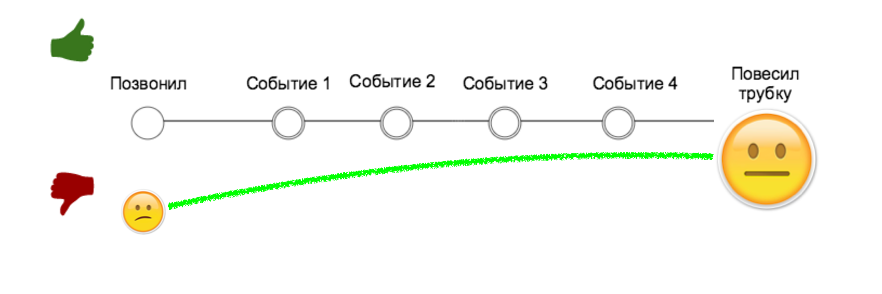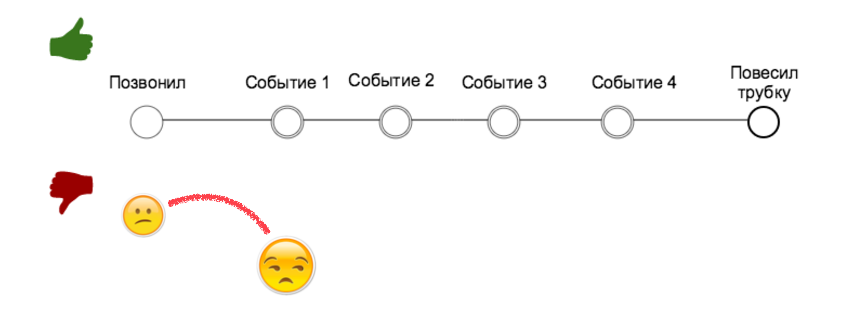Why customers do not want to talk to you? Efforts, part 1

I often write myself and meet in other articles the thesis “If you have good service, the client will return for shopping and will recommend you to friends”. But in fact, nothing is clear here.
What is included in the concept of service? Friendly communication staff? 24-hour telephone support on the site? Bots in the telegram? Bonuses and discounts? Should it all be good? Or one thing? And how “good”?
The thesis is, practical application - as in a fog.
Experts of Corporate Executive Board Co. polled 97,000 customers and 400 companies to find out which aspects of the service really affect the customer’s decision to stay with the company. As a result, the book "Always your client" appeared - a step-by-step guide for companies on how to organize a service to get loyal customers. The main idea of the book is that the key to customer loyalty is not wow service. Investing in the excellence of customer expectations is like burning a fireplace with money. Loyalty will not be added exponentially, as you would expect, but only by 2-3 percent. In fact, customers do not need you to surprise them. They want problem-free solutions. But only 16% of companies are able to do this in the opinion of customers. We want the percentage to be higher, so in a series of articles we will give a useful squeeze from the book and consider in detail the concept of “customer effort”. What it is, how loyalty is affected, what steps to take to reduce efforts. Today - about 4 types of effort that your customers experience.
')
Where does disloyalty come from
The customer has dialed your phone number.
Attention, question! What is the probability that he will hang up in a good mood?
If they answered no, then they are close to the truth. In fact, it is still worse. According to the results of the study, any contact between the client and the company is 4 times more likely to lead to a negative than loyalty.
Customer service is bad for loyalty
This paradox is discouraging, but now we will put everything in its place.
This is the customer mood scale.

He turns already upset. He could not check in for the flight, did not find the appropriate size of trousers on the website, or one piece of a toy for a child was not enough in the box.
The task of the company is simple - to perform some magical actions that will help to return emotions to a neutral state.

But according to statistics, the opposite is likely to happen: in the course of a conversation with the operator, something will happen that will completely ruin the mood of the client. The most destructive for the company is that disloyalty is contagious. The client will tell about the bad experience to friends over dinner, then publish an outraged tweet - and it went off. Experts have figured out what is included in this fatal thing - which events are more annoying and detract from customers, eventually pushing them to spread negative information about the company.
We will overhear the conversation of the operator with the client and note these moments when the client has to expend effort.
1. The problem is not solved the first time.
The client has a problem with checking in for the flight on the site. The employee recommends changing the browser and says goodbye. The client changes Chrome to Mozilla - the same thing: (Now, even more annoyed, he has to redial the number.

Cause of effort: the employee did not foresee possible problems in the future and did not give recommendations on what to do if the first advice does not help.
2. Impersonal service
-Girl, I have a mistake again!
-Have you tried changing your browser?
Yes, as I was advised, the same thing!
-What browser did you use?
-Girl, I urgently need registration !!! If you can not help, switch to older !!!
-No I can not switch you, what kind of browser did you use?
-Pi-pi-pi

The customer hung up. After 5 minutes, he will call again to get on another operator in the hope that he will listen and help.
Cause of effort: The employee did not show sympathy, indifferently repeating the script. The client had the feeling that the robot was on that side, and his need to be understood and heard was not realized.
3. Redirection
The third (!) Call to the company. The case seems to be moving forward: the customer is switched to the technical department. The first question is a new operator:
-How can I help?

Through the teeth, the client repeats the problem once again, suppressing the boiling desire to kill. “Next time I’ll write to the recorder and turn on the recording.”
The reason for the efforts: the client is transferred from department to department without preliminary comments for the next employee, forcing him to walk in a circle and constantly retell his sad story. The company does not have a system where the customer’s call history was recorded and is available to all departments at once.
4. Channel switching
A technical department specialist could not solve the problem, but he advised me to write to tech@support.ru and send screenshots.
- By the way, can you sign up upon arrival at the airport?

The reason for the efforts: the client was “transferred” to another place - to e-mail. It turned out that his question was initially worth solving in another channel and there is still no solution to the problem on the horizon.

Client after conversation.
Suppose the client would not call, spat on the error and simply decided to check in for the flight already at the airport. The result is the same, but the client’s attitude towards the company has not at least crossed the line of hatred. And now the company will lose it, along with several "infected" negative.
That is why customer service is harmful. To bring the client to neutrality, and especially to create a positive impression is difficult. That is why researchers advise not to concentrate on exceeding expectations, but on reducing disloyalty. To facilitate the client interaction with the contact center, to ensure that his condition is not shaken into negative. We found out 4 sick places, whence there are efforts and repeated addresses:
1. Related and future problems are not taken into account.
2. There is no individual approach.
3. The client has to repeat the problem.
4. Select the service channel, which will help, and change channels.
What the service manager can do to reduce the negative impact of each factor, I will tell you more about this in the following articles.
Source: https://habr.com/ru/post/302378/
All Articles